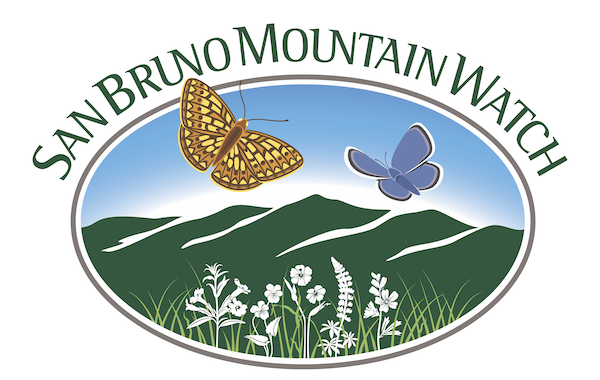Doug's Mountain Journal
A Chronicle of Natural History on San Bruno Mountain
Doug Allshouse has been writing his seasonal Mountain Journal for many years. It appears in the quarterly newsletters of the Yerba Buena Chapter of the California Native Plant Society (CNPS). We are very pleased to share his reflections on the natural history of the Mountain. Together with David Nelson, he is writing The Natural History of the San Bruno Mountains. The book will be published by Heyday Books.
May is a swing-month when we sense the end of spring and the prospect of summer. It’s when I finally get to hear the ethereal song of the Swainson’s thrush after listening to a few weeks of its water-drop call, a contemplating “whit” which, of course, I cannot resist answering back; thereby making me a thrush for a few moments, and a pretty good one, too. May is also the month when something noticeable happens and continues for a few months. The ocean spray bushes bloom with their clusters of creamy flowers thereby dotting the hillsides with many spots of creamy-brown. Then it occurs to me that there are indeed a bunch of them, more than I could imagine. The same happens with the buckeye trees in low creek draws.
In June the program changes again and as I gaze across Colma Canyon to the hillsides above April Brook I notice the bright yellows of lizard tail and the soft oranges of sticky monkey flower. What a lovely show is happening and the price of admission is free—if you enter through the Crocker Gate. Meanwhile, in Owl Canyon someone has spotted ladies’ tresses, one of our three native orchids.
Canada goldenrod
Act III takes place in July with the appearance of pink everlasting and its short pointed pink flowers and its leaves with their intoxicating minty-butterscotch aroma. Down in the lower bog just west of the lower Colma Creek Bridge are two patches of Canada goldenrod with their crowns of hundreds of riotous yellow flowers. It’s my little secret spot off the trail and it never fails to impress. The serendipity is that last year I was thrashing over the low coyote brush to check out a large tuft of pampas grass and stumbled upon the goldenrod, the only population I have seen on the mountain. Finally, the poison oak begins to turn bright red in late June and by mid-July large red splotches appear on the hills.
My book partner David and I were spending some time in the bog photographing the goldenrod and when we got to the Old Guadalupe Trail we ran into a dear friend, Mary. She’s quite an artist and illustrator and after some small talk she asked if we had seen the honey tree. I’m thinking “Honey tree? What’s a honey tree, some new invasive species?” We walk about 40 feet and she points to a eucalyptus with a fifteen-foot long split in the trunk and at the top of it is a large honeycomb with honey bees buzzing in and out. That was a cool discovery. I check on it almost daily but early on the cool foggy mornings we get this time of year the bees are huddled together like penguins in Antarctica. After discovering the bees we walk a bit further and I notice a female robin fly out of a short wax myrtle and land on a branch about fifteen feet away. I mention to David that there might be a nest in there so we look. Sure enough, at eye level there is a nest with 3-4 featherless fledglings huddled inside. So as not to ruffle Mom’s feathers he takes a few quick photos and we leave.
In Fog Forest, the large eucalyptus and cypress forest named for the fog that rains down, there are many leather ferns. There are also sword ferns and lady ferns but only leather ferns grow in the trees. Leather ferns are epiphytes - organisms that live on a plant but are not parasitic. They have root-like structures to anchor them but obtain all their needs—water, air and food—through their leaves. I have a favorite fern that grows on a trunk of a eucalyptus that snapped many years ago. The fern is about six feet off the ground and I tend to it by removing invasive English ivy around it. It looks like a snow cone with the trunk being the paper cup and the fern is the snowy ice.
Leather fern epiphyte on eucalyptus host
It’s been a quiet summer with the late spring migration being pretty lousy by other years’ standards. I heard one eastern vagrant singing, a Rose-breasted Grosbeak and there has been a dearth of Allen’s Hummingbirds this year. I did see a juvenile Brown-headed Cowbird that allowed me to get about four feet from it. Cowbirds do not build nests but the female lays an egg in a host’s nest and leaves the rearing to the hosts. It reminded me that about fifteen years ago I saw an adult male Wilson’s warbler with a juvenile cowbird in tow. The juvenile was about a month old and over twice the warbler’s size. I can imagine the warbler thinking “Jeez, it’s wearing me out trying to fill this guy up with food.” Thank goodness that the juvenile I saw today was on its own.
Fall is close and most plants will be getting ready to go to bed, only to reawaken a few months later.
See you on the mountain...


